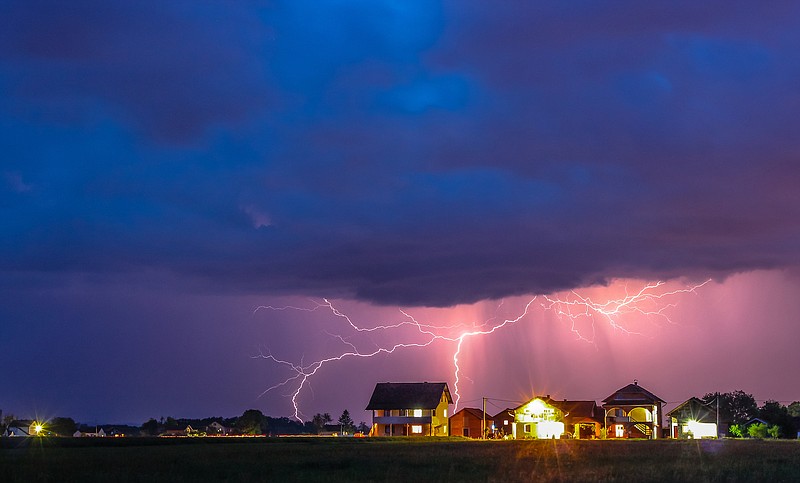My next-door neighbor, Jo, was in her living room reading. Her husband was watching television nearby. My husband was working at his computer, when suddenly:
Flash! Crack! Boom!
"The loudest thunder I have ever heard and a big white flash struck all at once jolting me out of my chair," Jo said. At our place, the thunderstruck dogs dove under my husband's desk and stayed there. Meanwhile, I was stuck in a circling plane that couldn't land due to the weather.
Lightning had struck a cable line between our houses, zapping both. Jo's house got hit worse. The strike took down her home's air conditioner, Apple TV boxes, internet, cable television, water heater and the smart system that controls the lighting and sound systems.
They would be weeks dealing with their insurance company and service workers to repair or replace the damaged systems, which, at last tally, cost an electrifying $40,000.
Meanwhile, at our place, the same bolt from the blue knocked out our air conditioner, cable television, irrigation control box and five recessed can lights.
All -- Jo and I now know -- could have been prevented had we had proper surge protection. Many power companies, including ours, provide it (for a fee) if you ask.
"What you had was a very near ground strike that was close to being a direct strike," said Peter Jackson, an electrical engineer at Kenick, a Florida-based company that makes surge-protection systems and provides them to utility companies in over more than 10 states.
About 80% of residents who sign up for his company's surge-protection program do so after they have a lightning strike, he added.
"Although you can't keep lightning from striking, you can keep it from getting in your home by capturing the spike and sending it into the ground before it enters the house and fries your refrigerator," said Jackson, who's been fighting lightning for 32 years. That's what the program's meter-based device does.
Electricians (not you!) install the unit behind your home's electric meter, where it monitors incoming power and diverts surges.
Those who want more protection can buy a plug-in surge protector to use indoors on sensitive programmable electronics, such as televisions and computers.
"Is the system perfect? No, but it's close," Jackson said. "It won't help if you have a direct strike on your house that blows a hole through your ceiling. But the good news is 95% of surge damage comes from indirect strikes."
Not every house needs surge protection at the meter, but all houses in lightning prone areas could benefit, he said. States with the most hits are in the Southeast and Midwest. While Texas gets the most lightning strikes a year, Florida holds the record for most strikes per square mile, followed by Louisiana and Mississippi.
Where lightning is less common, say on the West Coast, homeowners can get hard-wired surge-protectors online or from a big box store for around $100. These boxes install directly into your electric panel. Though the shock wave has to get into the circuit panel to be captured before it's sent back outside, these units do help, he said.
Lightning rods help prevent structures from burning, but don't provide much protection for appliances and electronics. "If you live in the tallest building around, a lightning rod might be a good addition. Otherwise spend your money on surge protection, not structural protection," he said.
Here's how else, Jackson recommends, you protect yourself and your home from the jolt of a bolt:
◼️ Take cover. The minute you hear thunder, get inside. You want four walls around you. Sitting on a covered outdoor patio is not safe. If a structure isn't near, get inside a car. Get off the golf course. Don't duck under a tree.
◼️ Get out of the water. Do not swim or be in water when a storm is in the area.
◼️ Put away the umbrella. Better wet than zapped. "You do not want to be in a thunderstorm with an umbrella," Jackson said. "It's basically a portable lightning rod."
◼️ Look for leaks. Check around your home, especially around your electric meter, for water. Make sure the ground isn't getting wet from a leaky hose bib or condensation. Lightning looks for the easiest path to ground, and wet ground is an easier path than dry ground.
◼️ Hire a licensed electrician. Regardless of which system you get, have a licensed electrician install it, "not just someone who's good with electricity," Jackson said.
◼️ Power strips aren't enough. Those bars that have multiple outlets are convenient, but don't protect what's plugged into them from voltage surges. To protect sensitive or programmable electronics, plug them into a surge protector or suppressor.
◼️ Watch for aftereffects. Not all lightning damage shows up at once. Some arrives days and weeks after the hit. Jo just called. Her pool lights are out.
Marni Jameson is the author of six home and lifestyle books, including "What to Do With Everything You Own to Leave the Legacy You Want."

